|
 Puccinia plagianthi Puccinia plagianthi
SynonymsPuccinia hoheriae
BiostatusPresent in region - Indigenous. Non endemic
Images (click to enlarge)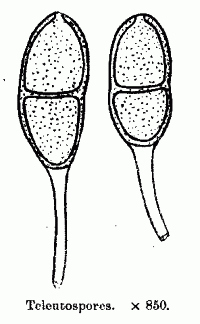 | 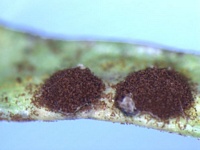
Caption: Pustules about 0.3-0.5 mm diam.
Owner: Herb PDD | 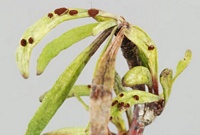
Caption: Pustules about 0.3-0.5 mm diam.
Owner: Herb PDD | 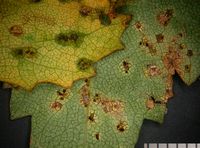
Owner: J.A. Cooper | 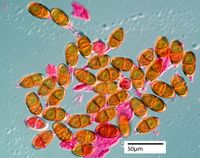
Owner: J.A. Cooper |
Article: Gadgil, P.D. (in association with Dick, M.A.; Hood, I.A.; Pennycook, S.R.) (2005). Fungi on trees and shrubs in New Zealand. Fungi of New Zealand. Ngā Harore o Aotearoa 4: xi + 437 p. Hong Kong: Fungal Diversity Press.
Description: Type: Rust and Smut Fungi; Description: Spermagonia in scattered groups, minute, immersed, yellow; on both sides of the leaf. Telia clustered, circular, dark brown, up to 2 mm in diameter, associated with pale yellow, brown or grey irregular blotches, up to 4 cm long; coincident on both surfaces of leaves, also associated with large, irregular, distorted areas on stems. Teliospores elliptical, 1-septate, 30–40 × 16–22 μm, finely pseudo-reticulate, golden brown; pedicel deciduous.
Distribution: Distribution: Auckland, Waikato, Bay of Plenty, Taranaki, Wanganui, Wellington, Wairarapa, Nelson, Westland, Fiordland, North Canterbury, Mid Canterbury, South Canterbury, Dunedin, Southland.; 1st Record: Cunningham (1923a).
Article: Dingley, J.M. (1969). Records of plant diseases in New Zealand. New Zealand Department of Scientific and Industrial Research, Bulletin 192: 298 p. Wellington:.
Notes: This rust was first recorded by Wakefield (1917) on Hoheria. Cunningham (1923b) using
the same specific epithet described it as a species morphologically distinct from Puccinia
plagianthi. Later (1931a) he concluded that it was synonymous with P. plagianthi. Rust
on Plagianthus and Hoheria is common in areas from Taranaki southwards in the North
Island and in the South Island. It is an indigenous species occurring also in Tasmania. All
host plants are endemic to New Zealand.
Article: Wakefield, E.M. (1917). Fungi exotici. XXIII. Kew Bulletin of Miscellaneous Information 1917(9-10): 308-314.
Notes: Near to P. Plagianthi McAlp., but distinguished by the smaller spores, with granular (not
reticulate) epispore. From P. Abutili it differs in the narrower spores with more finely
granular epispore.
|